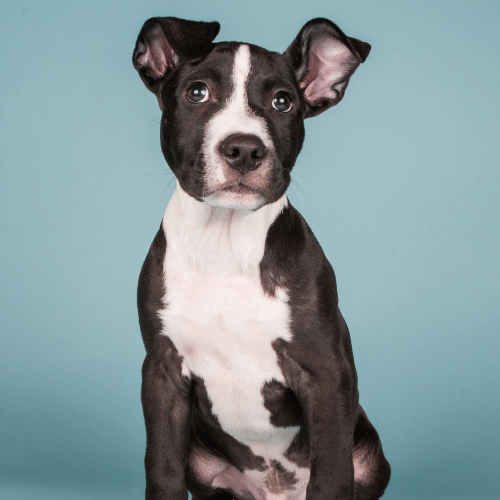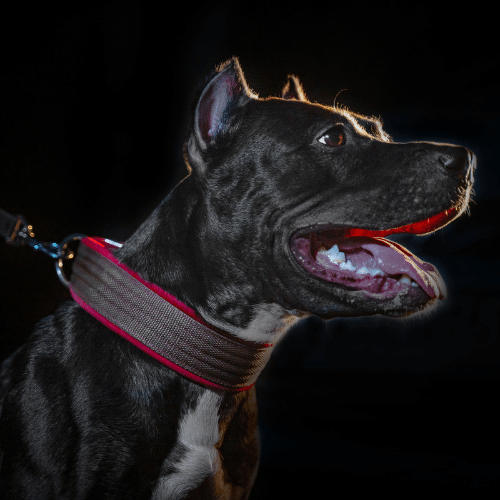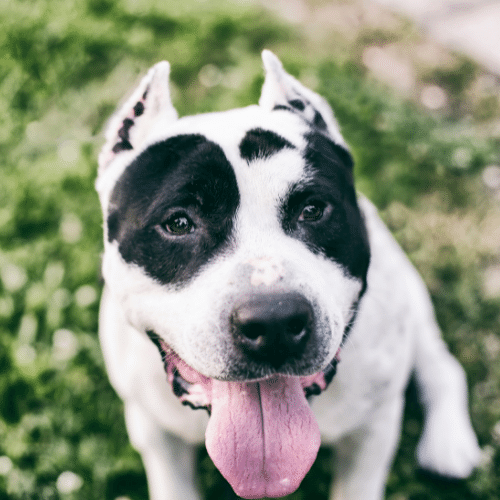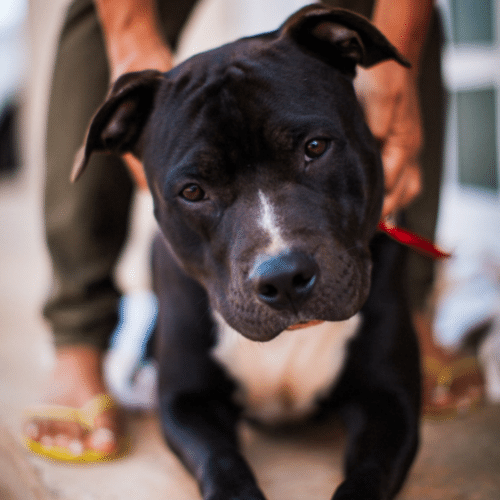Black and White Pitbull
July 9, 2021 2021-10-21 2:07What exactly counts as a “Pitbull” is a bit confusing. The term can either refer to any dog that is descended from bulldogs and terriers, or it can be a nickname for the American Pit Bull Terrier. It depends largely on who you’re talking to. In the United States, the first definition seems to take precedence. In the rest of the world, they typically use it as a shortened form of American Pit Bull Terrier.
This term can also be a reference to the American Staffordshire Terrier, which is simply a renamed and slightly different version of the American Pit Bull Terrier. The American Kennel Club simply didn’t want to use the term “pit” in the dog’s breed, so they renamed it.
In this article, we’ll be taking the latter definition for this breed. In other words, we’ll be using the term “pitbull” as a shortened form of the American Pit Bull Terrier. This is simply because the other definition adds many different dogs into the category, many of which are very different from each other. It is difficult to consider them all at the same time, as it depends on the breed you’re specifically talking about.
Consequently, many of the things discussed in this article will also be true for the American Staffordshire Terrier, though there may be some small differences.
Table of Contents

Appearance
The American Pit Bull Terrier is a medium-sized dog that usually weighs anywhere between 30-60 pounds. Males are particularly larger and usually fall in the upper end of this range, while females usually fall on the smaller end. They can stand up to 18-21 inches.
They usually have a short coat that is thin and obviously designed for cooler climates. Their coat is only single-layered and sheds quite profusely. The fur is often stiff and smooth to the touch. They often don’t require much grooming besides removing the extra hair that they shed out.
They are very muscular dogs, which comes mostly from their bulldog ancestry. Many of them are described as quite stout, though their terrier parentage also provides them with quite a bit of agility.
They can come in many different coat colors. In fact, every color is accepted except for merle by the UKC, which is only found in a few rare breeds. Coat patterns come in all shapes and sizes. However, solid and tuxedo are the most common. For black and white Pitbulls in particular, they will likely have a tuxedo coloring.
Black and white Pitbulls should not be confused with the similar looking, but lighter blue fawn Pitbull.

History
The American Pit Bull Terrier is a descendent of the Old English Terriers and the Old English Bulldogs. Both of these breeds are currently extinct, but they live on through this dog. This breed was originally bred to combine the strength of the bulldogs with the eagerness of a terrier. These dogs were mixed and bred in the British Isles. However, they were then imported into the United States, where they developed into the breed they are today. This occurred mostly in the late nineteenth century.
Originally, these dogs were used for bull-baiting and similar sports in the United Kingdom. However, these sports were banned in 1835, leaving this breed without a job. Their popularity started to decline for a while, though many were still used in dogfighting. However, they were then revived as a companion breed.
This dog was first recognized by the United Kennel Club in 1898. They tried to change the name to the American Bull Terrier, but the change didn’t stick, and they went back to the original.
Starting in the early 20th century, these dogs were mostly used to catch wild cattle and hogs, which were often too dangerous for other breeds to handle. They were also used to drive livestock and as general companion animals.
The AKC reluctantly accepted this breed but sought to distance it from the pit fighting of its early history. Therefore, they renamed the dog to the American Staffordshire Terrier, as the breed was developed in Staffordshire. Since then, the American Pit Bull Terrier and American Staffordshire Terrier have parted somewhat in their breed standards.
There is some confusion today over whether they count as the same breed or not. Some dogs have dual-registrations as both breeds.
Personality and temperament
There is a lot of misconceptions about this dog breed. They are often considered aggressive, but there is no evidence that they are any more aggressive than other breeds. In fact, aggression towards humans is considered to be a disqualifying factor in the show ring. They are bred to have a “reliable” temperament with people.
While there does seem to be an increase in pitbull-related bites in some statistics, there are a few problems with this. Many dogs are mislabeled as pitbulls, especially when there is aggression involved. In fact, even those who are experienced with dogs often mislabel dogs as pitbulls when they really aren’t. Therefore, it is likely that many pitbull bites aren’t actually done by pitbulls at all.
The AVMA states that breed is a poor predictor of aggressive behaviors. Instead, a dog’s socialization and training are a better indication of the dog’s future aggression. It is about how you raise the dog, not something innate that comes with their breed.
Simply put, these dogs aren’t any more aggressive than other dogs. They are quite intelligent and train easily. Many are great with children due to their patient nature. Often, they are even described as “nanny dogs” due to their ability to function well in family situations.
This dog absolutely loved people and is extremely people-oriented. They require quite a bit of attention and prefer to be with their people at all times. They don’t really know their own size, so they will often attempt to sit in people’s laps – even though they are usually much too large. They are extremely confident dogs and very alert. They can sometimes be noisy for this reason and make good watchdogs.
However, they are not good guard dogs, as they are more likely to lick an intruder than anything. Their loud bark is mostly because they are very excited to greet their new best friend!
Training and exercise needs of a black and white pitbull
Like all pitbulls and other breeds, these black and white dogs will need regular socialization. If you simply leave a puppy at home all day, these dogs will not learn how to interact with the outside world. When they are finally met with a new and unusual situation, they will often become fearful, which can increase the chance of aggression.
Therefore, it is important to introduce them to a wide variety of different people and animals at a young age. Puppy classes are a great option for this. It provides them with a chance to train and socialize at the same time in a safe, controlled environment. Plus, you know all the other puppies at the class are properly vaccinated and safe for yours to be around.

Luckily, these dogs are very easy to socialize with due to their confident nature. Their default state is to love everyone, so they quickly take to new people. They are intelligent and people-oriented, so they often train easily. The only major problem is that they can sometimes become overexcited, which can cause them to block out commands. They cannot be trusted off-leash for this reason.
Regular exercise is important for this breed. Often, this isn’t terribly difficult, as these dogs will happily do just about anything if their people are involved. Moderate walks and plenty of playtime are all they need in most cases. If you have children in your family, the dog will often play with them for hours.
The high prey drive of this breed means that the Pitbulls need to be carefully supervised with cats and smaller dogs.
Health and care
Common health issues
Despite the fact that they aren’t huge dogs, this breed has a higher than average occurrence of hip dysplasia. This is a serious problem that occurs when the hip joint does not fit together properly. This causes excess wear and tear of the joint, leading to everything from pain to lameness. Medication and supplements are enough to treat some dogs, but others need fairly expensive surgery. As many as 23% of these dogs have some sort of hip problem.
They are also prone to patella (kneecap) problems. Their kneecap usually sits in a joint on their femur, which allows them to move around freely as they walk. However, in some cases, it can slip out of place. Some dogs don’t have a kneecap and groove that line up well together, increasing the chance of dislocation. Elbow problems affect as many as 17% of dogs.
Some heart problems, such as congenital defects, are also a problem. Most dogs cared for by professional breeders are tested for these problems before they are bred. It isn’t odd for a dog to have a congenital heart defect but not show symptoms until much later in life. Therefore, testing is important to ensure that affected dogs aren’t bred, producing more affected puppies.
Degenerative myelopathy affects about 18% of pitbulls, though many others are carriers. This is a condition that affects the spinal cord. It results in the slow loss of feeling in the hips and back legs, leading to weakness and then paralysis. Symptoms may resemble hip dysplasia in some cases, which can make diagnoses confusing, especially in white and black pitbulls, as they are prone to both conditions.
We do know that this disease is caused by a genetic mutation that occurs in a number of breeds, including all pitbulls. It is recessive, so dogs have to inherit two copies to be affected. There is currently no treatment for this disease. Instead, supportive care simply helps the dog remain standing for as long as possible, which includes keeping the dog physically active.
This breed is at an increased risk of parvovirus than other breeds when not vaccinated. Therefore, it is recommended that these dogs are appropriately vaccinated. This will involve multiple vaccinations when the dog is young, as well as a yearly booster.
Pitbulls, in general, are prone to Demodex Mange. This is not a very contagious disease, but it can be very difficult to treat if it gets on a white and black pitbull. There are two main types: localized and generalized. Localized mange typically involved patches of hair loss and are relatively minor.
Generalized symptoms are more severe and cause serious illnesses in some cases. Usually, hair loss will affect the whole body, not just specific spots. The skin may bleed and scab over. While the localized variant is not genetic, the generalized type is caused by immunodeficiency. If a dog carries the gene for this deficiency, they have a higher chance of developing generalized symptoms when infected.
Ivermectin injections are the most common treatment for this disease and are widely available at most veterinary clinics. Oral medications can be used as well, especially if the injections are not effective.

Grooming
The American Pit Bull Terrier does not require regular grooming, except an occasional brushing session to remove the excess fur they’re shedding. These dogs do shed quite a bit, so some occasional brushing is often required. They will often shed extra during certain times of the year, especially as the seasons change. Brushing will also help keep their coat clean and spread around their natural oils, which will result in a healthier coat.
They will need an occasional bath when they get dirty. Often, they may develop a slightly oily coat and a doggie smell, which is a clear sign that they need a bath. It is important to clean them with a gentle shampoo, as they are prone to some skin problems.
Because they are white, they may appear dirtier than they actually are. You can get dog wipes if you want to keep their white coat looking clean, but it typically isn’t recommended to bathe them every time they get dingy. This can dry out their skin. Brushing sessions can help with their coat cleanliness, but wet wipes designed for dogs can help if your canine steps in some mud with their white feet.
Like all dogs, you will need to trim their nails regularly. Usually, this should be done about every two months, but it depends on your dog’s activity level and environment. Very active dogs will wear their nails down somewhat by themselves.
Their teeth will need regularly brushed with dog-safe toothpaste. Periodontal disease in dogs is extremely dangerous and leaves them open for all sorts of diseases. For this reason, keeping your dog’s teeth clean is extremely important. You will also have to schedule teeth cleanings with your vet to prevent serious periodontal disease from occurring.
Adopting a Black and White Pitbull
Many of these dogs can be adopted from breeders. Usually, you can find breeders that specialize in particular colors and patterns (such as also the Razor Edge Pitbull), which can help you find exactly what you’re looking for. Because these dogs are prone to so many health conditions that are preventable with the right testing, we highly recommend purchasing from a breeder.
Breeders are often more expensive. However, this is largely because breeders perform the correct health testing, which prevents unhealthy litters of puppies from being reduced. You may end up paying more money upfront, but this lowers the chance that you’ll need to spend $4,000 per hip on your dog when they get hip dysplasia. It saves you significant amounts of money in vet bills.
Most breeders charge around $1,200 for their dogs. However, extremely high-quality dogs can cost as much as $10,000.
These dogs are quite common at animal shelters. However, remember that many dogs are misidentified as pitbulls by animal shelter workers. Therefore, just because a dog is advertised as a pitbull doesn’t mean they actually are. Usually, shelters will charge $50 to $300 per dog. This covers all of their vet bills and other care they needed while at the shelter.
Many shelters may charge less for these dogs, as they often sit for longer in shelters due to misconceptions about their temperaments. Many people are slow to adopt a pitbull. Therefore, you may get these dogs even cheaper. However, you should keep in mind that these dogs often have unknown pasts. Therefore, they may be a bit unhealthier than dogs from breeders.
If you do decide to adopt these dogs from a breeder, be sure that you consider the lower cost a down payment. You should have at least $5,000 in an emergency fund to pay for any health emergencies and surgeries.
No matter where you adopt your dog from, be sure to ask for health records. Breeders and rescues should readily turn them over. If they don’t, you should be very cautious. It usually means that the dog hasn’t gotten the proper health care. Of course, many rescues won’t have the dog’s complete health records. However, they should be able to share what the dog has been treated for and the vaccinations they have received since their arrival.
Experience level of owning a Black and White Pitbull
Because these dogs are so energetic, we don’t recommend them for first-time owners. It is best that you have some experience with owning a dog before you commit to a pitbull. It isn’t uncommon for these dogs to be quite hyperactive. They are very terrier-like but in a rather large and muscular body. They often don’t understand their size, either, which means that they’re more prone to knocking down things than other large breeds.
They’re basically a medium-sized dog that acts like they’re a small terrier.
Training them is rather easy, especially if you have experience with other dogs. However, their energetic nature means that they sometimes won’t listen to commands. They simply get too excited. For this reason, they require more patience and observation than other dogs. Sometimes, you simply can’t trust them in certain situations.

This is one reason why you should never trust them off-leash. They often become too distracted by new people or dogs to pay attention to commands.
If you’re very interested in a pitbull as a first-time dog owner, we recommend doing plenty of research on dog training before you adopt. Read a few books and absolutely plan on attending plenty of classes. You should also exercise these dogs more than you think. A few thirty minutes sessions a day is best, as this will keep your dog worn out throughout the day.
It is possible to own these dogs successfully as a first-time owner, but you should prepare for a bit more work than you’d need to do otherwise. Understanding dogs is key to raising these canines properly.
The bottom line
Despite the many misconceptions about this breed, they are actually very friendly and great with children. They are sometimes called “nanny dogs” due to their patience and ability to get along well with kids of all sorts. They often get along with other dogs as well, though their excited nature may put other dogs off.
They are quite easy to train, though this doesn’t mean that they will always listen to commands. They are quite distractable. It isn’t uncommon for them to get too excited to listen, especially when new people are involved. This is one reason why we only recommend them for experienced dog breeds. It is important to understand your dog’s limits.
Overall, these can be wonderful family dogs. However, their high energy levels can be a problem for some families. They are best if you’re active, as this will help wear them down as well. If you love jogging, bike riding, or nearly anything else, these dogs can make a great activity partner. They also excel at canine sports, including agility and coursing. They love to please their people and run around at the same time.

Author: Kristin
Kristin was born in Tennessee and currently lives there with her husband and children. She is passionate about educating pet parents and helping them make the best possible decisions for their pets. She currently owns one dog, two cats, a lizard, and a variety of fish.

